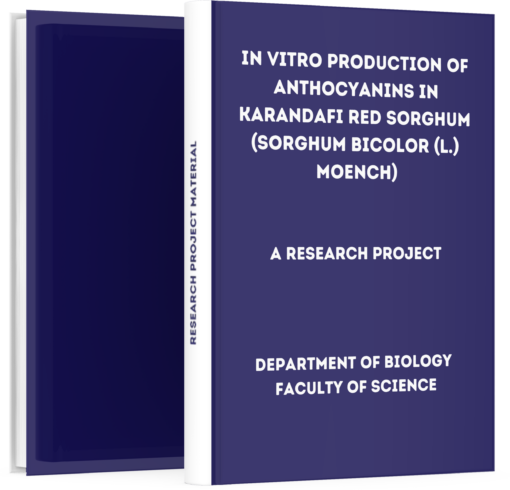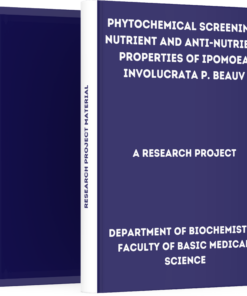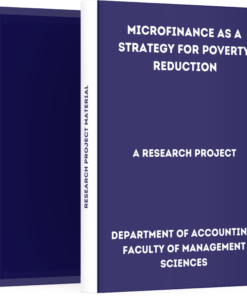In Vitro Production of Anthocyanins in Karandafi Red Sorghum (Sorghum Bicolor (l.) Moench)
₦3,000.00
If you are interested in getting this project material “In Vitro Production of Anthocyanins in Karandafi Red Sorghum (Sorghum Bicolor (l.) Moench)”, click on the DOWNLOAD BUTTON to make payment and the file will be delivered to your email immediately after confirmation.
Description
– In Vitro Production of Anthocyanins in Karandafi Red Sorghum (Sorghum Bicolor (l.) Moench) –
Download In Vitro Production of Anthocyanins in Karandafi Red Sorghum (Sorghum Bicolor (l.) Moench). Students who are writing their projects can get this material to aid their research work.
Abstract
This study was undertaken to produce and quantify anthocyanins in Karadanfi red sorghum in vitro. Mature embryo and immature embryo explants were used for callus induction using Murashige and
Skoog basal medium supplemented with varying concentrations of 2, 4-D (0 mg/L – 4.0 mg/L) alone or in combination with 0.5 mg/L KN.
Immature embryo was used for regeneration using MS media supplemented with BA (0 mg/L – 3 mg/L) alone or in combination with 2, 4-D (0.1 mg/L). The calli obtained were sub cultured on the media fortified with BA (0 mg/L – 2 mg/L) and NAA (0.2 mg/L) for anthocyanins production.
Results indicated highly significant difference for percentage callus formation, callus fresh weight, total and monomeric anthocyanins. Significant differences were also observed for percentage shoot initiation.
Medium fortified with 2 mg/L 2, 4-D alone or in combination with 0.5 mg/L kinetin was found to be optimum for callus induction. It was observed from this study that more 3-deoxyanthocyanindin can be obtained from in vitro grown sorghum at callus stage.
Introduction
1.1 Background of the Study
Sorghum (Sorghum bicolor (L.) Moench) is an annual plant that belongs to the family “Poaceae” Sorghum is an important cereal crop grown in the semi-arid tropics of Africa and Asia due to its drought tolerance capability.
It is well adapted to a wide range of soil types and environmental conditions (Sudhakararao, 2011). It is the fifth most important cereal crop in the world after rice, maize, wheat and barley, and is the dietary staple of more than half a billion people in over 30 countries (ICRISAT, 2010).
Sorghum species is one of the main foods that is widely consumed in Nigeria. Different parts of the crop are widely used in traditional medicine.
Sorghum bicolor is a rich source of various phytochemicals including tannins, phenolic acids,anthocyanins, phytosterols and policosanols (Sudhakar et al., 2008).These phytochemicals have significant impact on human health.
How to Download this Project Material
First, note that we are one of the best and most reliable online platforms because we don’t retain any of your personal information or data as regards making payments online.
PRICE: ₦3,500 ₦3,000 (Three Thousand Naira Only)
Make a bank deposit or mobile transfer of ₦2,000 only to the account given below;
Bank Name: UBA Account Number: 1022564031 Account Name: TMLT PRO SERVICES
After making the payment, CLICK HERE to send the following on WhatsApp;
- Depositor’s Name or Screenshot of Payment
- Name of the Past Question
- Active Email Address
or Call Us On +2348082284439 Once your details have been received and your payment confirmed by us, you will receive the past question in your email or WhatsApp within 5 Minutes.
Guarantee of Getting the Material
We understand that due to the high rate of fraud, many people are afraid of making purchases online but be rest assured that PastExamQuestions will deliver your material after payment.
Once your details have been received and your payment confirmed by us, you will receive the past question in your email or WhatsApp.
Give us Feedback
Have we been able to satisfy you? How well do you think the material will be helpful after having gone through it? Does the price worth the material?
Let’s hear from you! We recommend that our customers give feedback at the end of every transaction to enable us to serve better. You can do this by clicking the review button on this page.
Where is the review button? >> Just scroll up to where you see reviews





Reviews
There are no reviews yet.